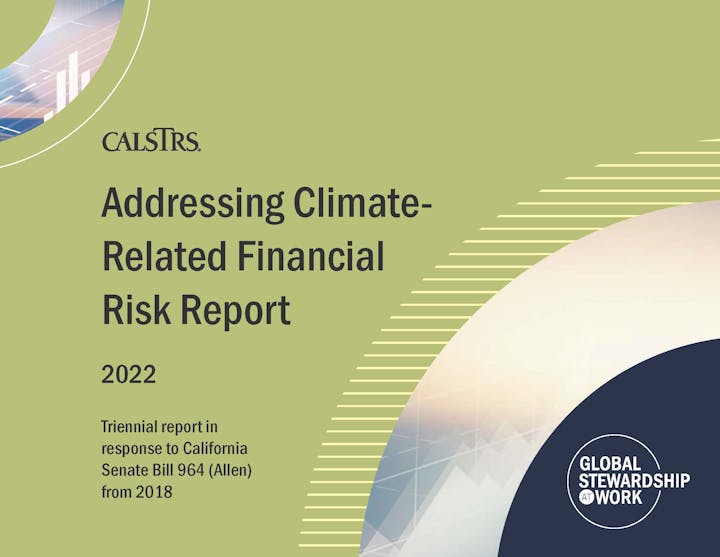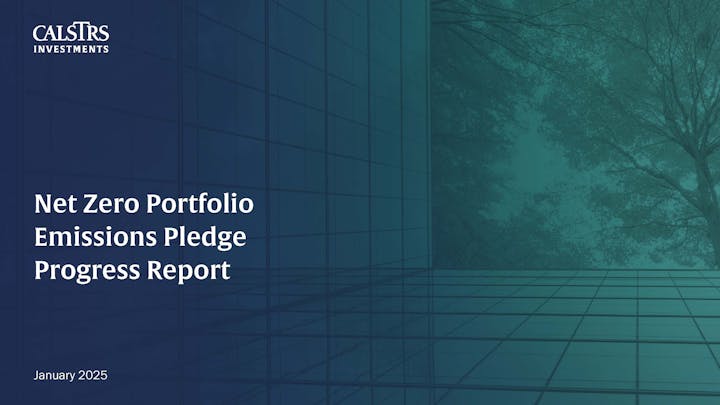Path to net zero
We believe climate change is one of the greatest threats to our future, with undeniable links to business and financial investments. Climate change impacts health and safety, the environment and the global economy, which puts the CalSTRS Investment Portfolio at risk. Our mission is to support the retirement security of California’s public school educators. Virtually all companies and assets in our portfolio are affected by climate risk and must prepare for climate change.
In September 2021, the Teachers’ Retirement Board pledged to achieve net zero greenhouse gas emissions across the CalSTRS Investment Portfolio by 2050, or sooner. The Board later adopted a science-based interim goal of reducing emissions from the portfolio by 50% by 2030.
Net zero means the amount of greenhouse gases emitted is offset by the amount taken away. The Board's pledges acknowledge the importance of the climate change challenges impacting the world and helps ensure we remain resilient and sustainable.
These actions integrate our net zero strategy across the CalSTRS Investment Portfolio in a total fund approach. This strategy has three pillars:
- Managing and reducing emissions in the portfolio.
- Influencing policy makers, companies and financial markets to speed up the global low-carbon transition.
- Increasing investments in climate solutions.
Managing and reducing greenhouse gas emissions
The first pillar of our net zero strategy is managing and reducing portfolio emissions, which are the greenhouse gases emitted by the companies and assets we invest in on behalf of California’s public educators. We do this by using science-based tools to measure emissions in our portfolio. Our goal is to align our emissions reductions with the Paris Climate Agreement. We report these measurements regularly and use them to inform our investment decisions and our priorities for influencing companies and policy makers.
We will continue to focus on stewardship and engagement efforts and investing in climate solutions that will further reduce greenhouse gas emissions and risks related to our portfolio.
Recent activities
The Global Equity team continues to implement an emissions reduction strategy by allocating 20% of the Total Public Equity portfolio to a low-carbon index, approved at the September 2022 Investment Committee meeting. As of June 30, 2024, approximately $21.7 billion or 15.4% of the portfolio is being managed internally against the low-carbon index. Staff estimates this has yielded portfolio emissions reductions of approximately 11.6%.
The Fixed Income team is implementing an emissions reduction program through an initial 15% carbon reduction strategy, approved by the Teachers' Retirement Board at the May 2023 Investment Committee meeting. In this strategy, Fixed Income’s credit-related indices reduce carbon emissions incrementally each month while seeking to maintain parent index metrics and minimizing additional active risk. At the same time, Fixed Income’s credit-related portfolios reduce emissions in like fashion. As of June 30, 2024, the strategy has enabled the team to reduce Fixed Income portfolio emissions by approximately 8% while maintaining active risk within modeled expected levels.
Speeding up the transition
The science is clear: To ensure the future of our planet, the economy must move toward net zero greenhouse gas emissions. And to achieve our net zero goals, we need the companies in our portfolio to speed up emissions reduction efforts. We use our influence to promote an accelerated transition in three ways: voting on shareholder proposals, engaging with companies, and public policy and regulatory advocacy.
Recent activities
Staff is engaging and encouraging portfolio companies to join the Oil & Gas Methane Partnership 2.0 (OGMP 2.0). OGMP 2.0 is a United Nations Environment Program initiative that requires member companies to measure their methane emissions (as opposed to estimating them), and to set emissions reduction targets. Since staff began engaging oil & gas companies on OGMP 2.0 at the beginning of 2023, 15 companies have joined, including Exxon Mobil Corporation and Chevron Corporation, and more than 100 companies in the CalSTRS portfolio are eligible to join.
As part of the 2024 proxy season, CalSTRS increased the scrutiny of our votes against boards that are not appropriately managing and addressing sustainable business practices. We voted against the boards of directors at a record 2,258 global companies because they did not provide necessary climate risk disclosures. Disclosure is important for investors to appropriately assess the financial risk climate change poses to a company’s long-term profitability.
Recent stewardship engagements
Examples of our engagements include:

Recent activities
The SISS Private Portfolio, which was approved by the Investment Committee in 2021 to create a systematic platform to expand investments in low-carbon solutions, has deployed over $2 billion to date across a broad risk-return spectrum.
The private asset classes have been working to increase exposure to low-carbon solutions. Examples of these types of efforts include:
- CalSTRS owns 33.3% of Arevon Energy (alongside fellow asset owners APG, in the Netherlands and ADIA in Abu Dhabi), which is a fast-growing renewable energy company that develops, builds, owns, and operates solar energy and energy storage projects in diversified power markets across the U.S. Arevon ranks as the fourth largest solar operating company in the U.S. and its solar and storage businesses positively contribute to the energy transition and climate change mitigation efforts. Arevon is a preeminent developer and holder of renewable energy assets that oversees approximately 160 clean energy projects totaling more than 3 gigawatts (1 gigawatt is equivalent to one billion watts and is estimated to power 750,000 homes per year) with an additional 78 gigawatts in its development pipeline. The company is committed to advancing its greenfield development program and to expanding the operating assets that provide solar renewable power to over 840,000 homes annually.
- CalSTRS and an industrial joint venture partner are working on the construction of a six-building industrial complex comprised of about 3.3 million square feet to be built on a 240-acre site located in Swindon, England. The development exemplifies sustainable development practices from planning to demolition and design. The site was formerly used for aircraft production during WWII and later for car manufacturing. The plan is to recycle more than 98% of construction waste from the site and to deliver a net zero carbon construction project. In addition, the project will retain much of the existing woodland and enhance it by planting about 48,000 trees and woodland shrubs. The buildings utilize best in class sustainability practices by using solar thermal water along with rainwater harvesting systems and EV charging. The frame of the building is being designed and constructed to accommodate future solar panels.
- A $20 million commitment in a software-as-a-service (SaaS) provider of renewable energy asset performance management software to over 200 utility-scale owners, operators and independent power producers and global energy majors, primarily in North America and Europe. The company’s software monitors over 110 gigawatts of wind, solar and energy storage assets worldwide.
- CalSTRS has an ownership stake in Generate Capital, a leading sustainable investment and operating company that builds, operates and finances clean energy, transportation, water, waste, and digital infrastructure. Founded in 2014, Generate Capital has built one of the largest organic waste recycling businesses in North America with a capacity to process more than 1.8 million short tons of organic waste. The company was also an early mover and first to scale in distributed solar, energy storage and microgrids, owning and operating 342 megawatts of distributed solar, 149 megawatts of battery storage, and 246 megawatts of microgrids. The company’s Infrastructure-as-a-Service model enables the infrastructure and energy transition for thousands of customers, companies, communities, school districts and universities.
Investing in climate solutions
We focus on investing in companies and assets that meet our investment return objectives and reduce portfolio emissions, such as producing renewable energy or constructing and managing buildings that meet the highest standards for energy efficiency.
Since 2004, we have been actively integrating climate-oriented solutions into our portfolio and have invested more than $43.6 billion in low-carbon solutions.
Examples of these investments include:




